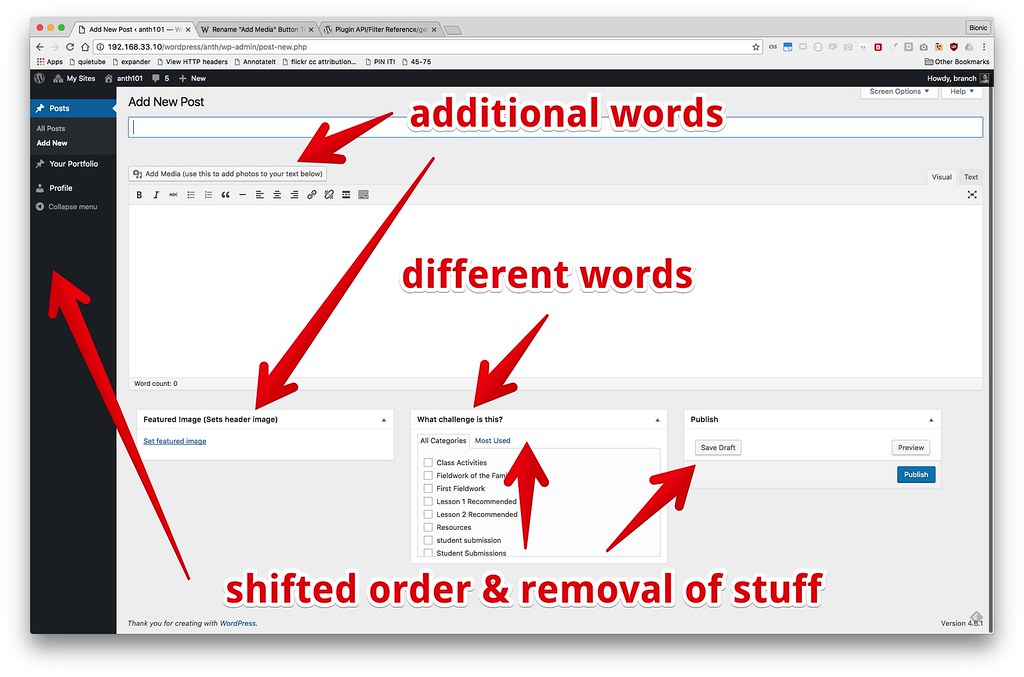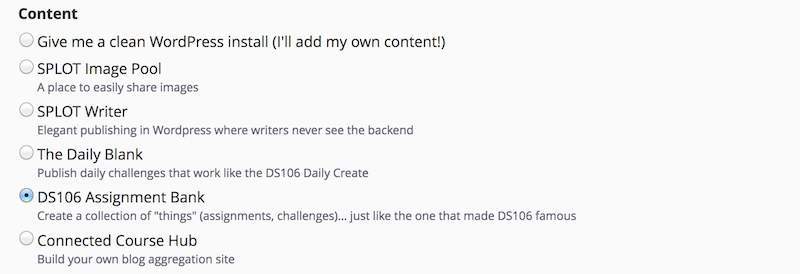I like the granular nature of what they’re able to offer, echoing @acroom’s tweet the onboarding process is really slick and instead of just prebuilt templates with all the decisions made for the user (which also has value of course) it’s cool to have a way in which you could see someone making decisions like that step by step as the get started with their domain.
You’re very welcome!
Yeah, there are simple things here that would be nice for someone to do before they see CPanel–choose an application for their root domain which would then open up a set of options such as choosing a default theme, enabling a couple of plugins, etc. It’s quite brilliant and works toward solving the biggest complaint I hear the most, which is some version of “Hey, I signed up for OU Create but then I got too overwhelmed with CPanel so I left.”
I’m curious if the template approach would be helpful for me specific to Commons in a Box (http://commonsinabox.org/). I’ve had requests for assistance from folks wishing to maintain faculty learning communities. We’re trying to avoid overuse of our LMS for this purpose, and I’m wondering if it makes sense to rely upon a template like you describe when the Commons in a Box project may upgrade their collection of plugins, themes, etc. In other words, when your WordPress-based project might drift from your template, is it still a good candidate?
To be fair, the Common in a Box setup process if pretty efficient, but it would be great if I could save even more time.
Pretty sure since he tweeted it this is public and I can mention it.
Reclaim Hosting is a partner on this grant to bring on CBOX as an actual installer through Installatron.
Regarding that question the templates as outlined here are really only about the starting point. I would think the expectation should be that it’s an immediate fork and the people that use them aren’t going to get updates (outside of plugins and themes updating themselves which WP is already great at).
The discussion in this forum led to a workshop I did last week at the DML Conference using a set of 5 Wordpress pre-built sites (2 SPLOTs, a Feed Wordpress demo site, and DS106 Assignment Bank / Daily Create) made available (with Tim’s help) to people creating accounts on the Reclaim StateU.org site.
The hope was giving people a ready built site with all plugins, settings, and sample content, they could more quickly explore and modify their own copy.
They appear as options on the Wordpress installer:
In the dog food consuming vein, we hosted the workshop materials there too (that was a static HTML5up template) and Tim says they will leave it on the site as an open resource:
http://connectedcourses.stateu.org/
A few observations / notes:
- It’s a Snapshot Copy. The process was I made the “source sites” as installs within my account there, sent Tim a link, and 3 seconds later it was added to the Installatron. I had worries about what might happen if someone finds the sources and change the content, but what gets added is a snapshot of the source. This does mean if you find some things to change, Tim would have to completely redo what he did.
- It copied perfectly Everything came across on the new site, even the secondary hidden user accounts I use on SPLOTS. My hunch is it works just like the Clone Site function I have used before within a Reclaim account, this merely lets you copy from another account. It looks like it does a search and replace on all of the base URLs for the site in the database, including internal links and image embeds. What it seems to do is replace the email address and password for the user id= 0 the admin of the site with what the Installer asks for on the setup. The other account I had also seemed to have its password changed. But everything else- plugins, settings on plugins, all content, menus, everything was cleanly duplicated
- One Bottleneck We had 17 people at the same time setting up StateU accounts, and apparently that authentication process is a bottleneck. The site got really slow until all had gotten setup. If I was doing again, I might have people do this ahead of time. After that, the response time was great.
- People Can Still Get easily Confused it took a while for people to differentiate what feels natural to experienced users- the different between the StateU “Dashboard” and the Wordpress ones they were creating. I did throw a lot at them for a 6 hour session. Also, uphill was getting them to understand that this was more sandbox and not a place to build out things. And some people that StateU was really a University.
All in all I am very pleased for how it worked to immerse a lot of people into a deeper level of Wordpress, even ones who have been using it for years but mostly as a blogging tool. I don’t know what it takes to put into a production environment, I imagine any school running a domains project can do this.
But there is value in giving people more than a blank WP site to start with. Thanks again, Tim / Reclaim.
Thanks for this, Alan. I think many long-time WP users take for granted how intimidating the blank slate of a WP install can be. I’ve watched lots of new WP users, and it usually only takes about an hour or two for it not to be terrifying. But the looks on faces during that first hour can be a little like an 80s slasher film. I’ve been thinking about developing a WordPress theme (could also be a plugin) that builds on-boarding into the theme itself. You or anyone seen such a thing out in the wild?
Yes, almost exactly like that. Except what I was imagining is something pedagogically-tuned. One that would help a faculty member using WordPress think through ways to use the platform for teaching. So tech guidance, a little, but also nudging folks toward thinking about the pedagogical possibilities of the platform. There are a bunch of LMS-style themes and plugins. But nothing I’ve found yet that is more critically oriented or aimed at helping folks build student-centered learning spaces with WordPress. Honestly, your approach to “cleansing the dashboard” is a good first step. In some ways, that dashboard too strongly dictates how one ought to use or think about WordPress. We all see through the dashboard to some extent, because we’ve been using it for so long. But I watch a lot of new users tussle with it, and even though I think it has improved considerably over the years, it’s still a bear. And not A Single Bear.
The raw bones of that plugin seem like it might enable that path. It’s on my list of things to do . . .
Random Unoriginal Thoughts
I think Discourse gives more tools/capabilities as you spend time/do things in the platform. I wonder about that kind of release of complexity but it makes other things much more of a hassle because you have varying interfaces per person which generally creates confusion.
I think more and more along the lines of SPLOTs and streamlining whatever tool to the bare minimum for the task/process (but also fight with myself about that). It certainly gets more people moving faster towards the stated goal.
For the anth101 site, Mike and Ryan were dealing with many, many hundreds of students so we ended up with the interface below. It’s an attempt to customize the interface so you have only what you need and does things like changing the generic term “categories” to “What challenge is this?”

I don’t know if this removes students from the possible understanding that challenges are categories and so prevents them from ever really getting that categories can be used to do X and Y (not to mention Z). There are probably lots of scenarios where that’s not happening anyway (so you have the penalty and no benefit) but I think this kind of streamlining probably further lessens any incidental learning that might occur otherwise.
Slippery slopes, unintentional consequences, digital fluency, barriers to entry, as simple as possible but not simpler etc. etc. I’ve yet to find a happy path between endless attempts to figure this out and actually getting lots of stuff done.
